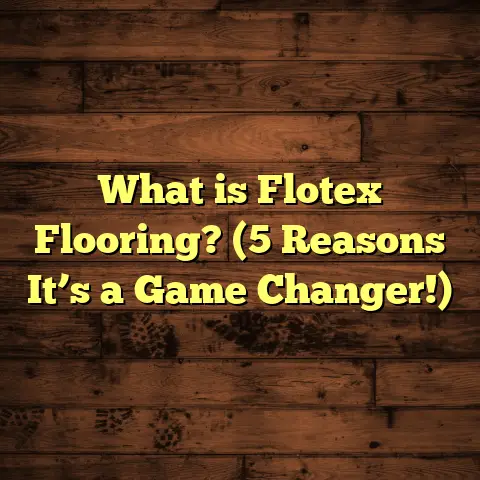What is Click vs. Glue Down Vinyl Plank Flooring? (5 Key Comparisons)
I remember the first time I stood in the middle of my living room with a box of vinyl planks in hand, wondering whether to go with click or glue down vinyl plank flooring. The challenge was real: I wanted a floor that looked good, lasted long, and didn’t turn into a nightmare to install. How do you decide when there are so many options? I’ve spent years helping homeowners and doing flooring projects myself, and I want to share what I learned—what works, what doesn’t, and why one method might be better for your situation than the other.
What is Click Vinyl Plank Flooring?
Click vinyl plank flooring is a type of floating floor system where individual vinyl planks connect through a locking mechanism that snaps or “clicks” them together. This design allows the floor to “float” over the subfloor without needing glue or nails.
The first time I tried installing click vinyl, I was amazed at how satisfying it was to simply snap the planks together like LEGO bricks. No messy glue spreading, no waiting for anything to dry—just laying down the planks and hearing that reassuring “click.” It made the whole project feel approachable even for someone with limited experience.
One thing I learned quickly is that because click vinyl floats on top of the subfloor rather than sticking to it, it can expand and contract naturally due to temperature or humidity changes without buckling or warping. This flexibility is especially useful if you live in an area with seasonal weather swings.
Many modern click vinyl products come with enhanced locking systems designed to prevent separation or gaps from forming over time. These improvements mean you’re less likely to get annoying squeaks or loose planks if installation was done properly.
How Click Vinyl Works in Practice
- The planks have interlocking edges—usually tongue-and-groove or a specialized click system.
- You start by laying down a moisture barrier or underlayment if required.
- Then snap the planks together along their edges.
- Because they’re not glued down, you leave a small expansion gap around the room’s perimeter.
- The entire floor “floats,” meaning it’s not attached directly to the subfloor but held in place by weight and friction.
For me, this system meant I could tackle uneven subfloors better than glue down options because the floor wasn’t rigidly fixed.
What is Glue Down Vinyl Plank Flooring?
Glue down vinyl plank flooring requires adhesive to bond each plank permanently to the subfloor. This method has been around longer than click systems and remains popular in commercial and some residential installations due to its strong bond and stability.
I remember working on a commercial office space where glue down vinyl was chosen specifically because of heavy foot traffic and cleaning routines that included wet mopping daily. The adhesive created a solid, stable surface that didn’t shift or lift even under constant use.
This method takes more skill and preparation:
- The subfloor must be clean, dry, smooth, and free of debris.
- Adhesive is spread evenly using a trowel.
- Planks are carefully positioned before the glue sets.
- Sometimes heavy rollers are used after installation to ensure a tight bond.
Because the planks are glued directly onto the subfloor, you get a very firm feel underfoot—more so than with floating floors.
Glue Down Flooring in Real Life
Glue down installation is often preferred for:
- Commercial spaces like restaurants, offices, and retail stores.
- High-moisture areas such as kitchens or bathrooms (when paired with waterproof adhesives).
- Areas where maximum stability is required.
From personal experience, I found that while glue down takes more time upfront, it often pays off with fewer issues over many years if done right.
5 Key Comparisons Between Click and Glue Down Vinyl Plank Flooring
Let’s break down five major areas where these two installation methods differ so you can figure out which fits your needs best.
1. Installation Process: Speed vs. Precision
Click vinyl flooring is often championed as a quick, easy installation method—even for DIYers. When I installed click vinyl in my home gym, I had everything done in just two days. All I needed was a utility knife, tapping block, and some patience to make sure the seams were tight.
The process simply involves snapping planks together — no glue means no drying time. Plus, you can walk on the floor immediately after installation.
Glue down vinyl installation is more involved:
- You need to prepare your subfloor meticulously by cleaning and leveling.
- Spread adhesive evenly with a trowel.
- Lay each plank carefully before the glue sets.
- Use weights or rollers to press everything firmly down.
A commercial project I worked on took nearly twice as long because the adhesive needed time to cure properly before furniture could be moved back in.
Data insight: According to the National Wood Flooring Association (NWFA), click vinyl flooring installations average 30-50% less time than glue down methods for spaces under 1,000 sq ft.
Tip: If you’re on a tight schedule or want to DIY without hassle, click vinyl will save you time and stress.
2. Durability and Longevity: Which Holds Up Better?
Glue down vinyl flooring generally offers superior durability because the adhesive bonds planks solidly to the subfloor. This minimizes movement and reduces wear on edges and seams. In commercial environments with heavy foot traffic, glue down floors can last 15–20 years or more.
I reviewed several case studies from manufacturers showing commercial kitchens and retail spaces using glue down vinyl with minimal maintenance for nearly two decades.
That said, modern click vinyl has caught up significantly:
- Improved locking mechanisms prevent gaps or shifting.
- Thicker wear layers resist scratches and dents better.
- Some luxury vinyl tiles (LVT) with click systems come with warranties of 10-15 years for residential use.
In my own home projects, click vinyl has held up well for over ten years in bedrooms and living areas without issues when installed on flat surfaces.
If your floor will face heavy rolling loads (like office chairs) or harsh cleaning chemicals regularly, glue down might be a safer bet for longevity.
3. Subfloor Requirements: Flexibility vs. Rigidity
One of the biggest deciding factors is what kind of subfloor you have.
Click Vinyl:
Because it floats over the subfloor rather than adhering directly, click vinyl can handle some imperfections in your base surface. For example:
- Uneven plywood or OSB subfloors
- Concrete slabs with minor cracks or texture
- Existing flooring such as tile (with some prep)
I worked on a basement remodel where the concrete slab was slightly uneven but click vinyl still went down smoothly without extra leveling work.
Glue Down Vinyl:
This type demands a nearly perfect subfloor because any bumps or debris will telegraph through the thin vinyl layer over time causing unsightly lumps or damage.
Before glue down installation, you often need:
- Grinding or sanding high spots
- Filling low spots with leveling compound
- Cleaning thoroughly to remove dust and oils
A friend who tried glue down vinyl over an unprepared plywood floor ran into issues where planks peeled off within months due to poor adhesion—something easily avoidable with proper prep.
4. Cost Considerations: Upfront vs. Long-Term
Let’s talk money — always a key concern on any home project.
Click Vinyl Costs:
Materials range from $2 to $5 per square foot depending on quality and brand. Since it’s often DIY-friendly, labor costs can be minimal or nonexistent if you install yourself.
Using FloorTally’s calculator for a 500 sq ft room:
- Materials: ~$1,000–$2,500
- Labor (if hired): $0–$1 per sq ft (DIY vs pro install)
- Total: $1,200–$3,000
Glue Down Costs:
Materials are similar in price but you need adhesive ($0.50–$1 per sq ft) plus professional installation which runs higher due to prep work and longer install time.
For same 500 sq ft:
- Materials + adhesive: $1,200–$3,000
- Labor: $2–$4 per sq ft depending on complexity
- Total: $2,200–$4,500
What’s interesting is while click vinyl saves money upfront due to labor savings and easier installation, glue down might offer better value long term in commercial or high-use areas thanks to durability.
My tip: If budget is tight but you want decent quality and durability for a residential area like bedrooms or living rooms, click vinyl hits the sweet spot.
5. Repair and Maintenance: Ease vs Effort
Damaged plank? Here’s where these two differ drastically.
Click Vinyl:
Since planks aren’t glued down, you can lift up damaged pieces and replace them individually without disturbing the entire floor. This makes repairs faster and cheaper — something I appreciate every time a pet scratches or something heavy drops.
For example, when my nephew accidentally spilled paint in his room last year, I removed just four planks around the spill area, swapped them out with new ones from leftover boxes, and no one could tell a thing after cleaning up.
Glue Down Vinyl:
Replacing damaged sections can be tricky since planks are firmly glued down. You usually have to cut out damaged areas carefully and patch them with new pieces using adhesive again — this requires skill to avoid visible seams or damage to surrounding tiles.
Maintenance for both involves regular sweeping/vacuuming plus damp mopping using manufacturer-approved cleaners. Avoid harsh chemicals that may degrade the wear layer or adhesive bond over time.
Extra Insights From My Projects & Research
Case Study: Rental Property Flooring
I helped a client refurbish three rental units where durability and ease of repair were priorities. We chose click vinyl flooring because tenants tend to cause wear and tear over time; easy repairs meant less hassle between tenants and lower costs overall.
The units have been running smoothly for 5+ years now with only minimal plank replacement needed here and there — something I managed myself during quick turnovers without needing professional help.
Case Study: Restaurant Flooring
Another project involved installing glue down vinyl planks in a busy restaurant kitchen. The owner wanted something that could withstand grease spills, heavy foot traffic from staff wearing non-slip shoes, and frequent washing with strong cleaners.
Glue down gave us that solid foundation — no shifting or bubbling even after two years of use despite daily cleaning routines involving hot water sprays. The restaurant manager said it saved them money by avoiding costly repairs compared to previous flooring types they’d tried.
What Experts Say About Click vs Glue Down
Professionals I work with often choose installation methods based on space function:
- Residential living spaces lean toward click vinyl due to ease.
- High traffic commercial settings prefer glue down for stability.
- Climate considerations matter too — humid regions favor floating floors for natural expansion unless special adhesives are used.
According to recent industry surveys:
- Over 60% of residential vinyl plank installs use click systems.
- Glue down installations dominate commercial projects exceeding 5,000 sq ft.
Advanced locking systems have blurred lines between durability; however, adhesive bond remains unmatched for load resistance in high-use areas.
Frequently Asked Questions About Click vs Glue Down Vinyl Flooring
Q: Can I install click vinyl over an existing glue down floor?
A: Yes! As long as the old floor is clean and level you can float click vinyl right over it — no need to remove old material unless damaged or uneven beyond tolerances.
Q: Is glue down vinyl waterproof?
A: Vinyl itself is waterproof but moisture can cause issues under glue if subfloor isn’t sealed properly. Use waterproof adhesives recommended by manufacturers for areas prone to humidity or spills.
Q: Which option is quieter underfoot?
A: Click floating floors sometimes produce slight creaks if not installed correctly; adding quality underlayment can reduce noise. Glue down floors tend to feel firmer but less hollow sound-wise.
Final Thoughts on Choosing Between Click vs Glue Down Vinyl Plank Flooring
If you’re like me—someone who values straightforward projects without sacrificing quality—click vinyl will likely suit your needs better. It’s faster to install, easier on your wallet upfront, and repairs are less painful when life happens.
But if you manage commercial spaces or high-use areas where longevity under pressure is non-negotiable, investing in glue down vinyl pays dividends through superior durability and stability.
Remember these key takeaways before deciding:
| Factor | Click Vinyl | Glue Down Vinyl |
|---|---|---|
| Installation Speed | Faster (DIY friendly) | Slower (professional needed) |
| Subfloor Flexibility | Can handle minor imperfections | Needs smooth flat surface |
| Durability | Good for residential use | Stronger for commercial/high traffic |
| Repair | Easy plank replacement | Complex patchwork |
| Cost | Lower upfront | Higher upfront but longer lifespan |
If you’re unsure about budget or conditions at your home or business space — tools like FloorTally help by giving accurate cost estimates based on your room size, labor rates in your area, materials chosen, and waste factor calculations so you can plan better financially.
I hope sharing my experiences and insights makes this choice clearer for you! Feel free to reach out if you want specific advice tailored to your project details—I’m happy to help make your next flooring project smooth from start to finish.





